TV for kids isn't dead – they're just watching it in different ways
We are seeing an advance in services offered to the younger generation

Is this the end of TV viewing as we know it? That's what research agency Childwise would have you believe as they release their results of an annual survey tracking children's media behaviour in the UK.
Describing it as a 'landmark change', Childwise revealed that youngsters aged five to sixteen are now spending more time online than on traditional linear TV. The survey apparently heralded the beginning of the end for television shows, as more under-16s preferred gorging on YouTube videos than watching long-form telly.
A closer look at the stats, however, suggests we shouldn't be worrying about the death of TV quite yet. First, the amount of TV that children are watching has dropped only slightly in the last fifteen years, with youngsters watching on average fifty minutes less than they in 2000.
It's clear that these fifty minutes are now being spent online rather than in front of the TV, which is understandable. The younger generation communicate more through social media and older teenagers now spend an increasing amount of time on YouTube in the company of their favourite Vloggers.
The survey also suggested that linear TV in particular is on the wane. Childwise revealed that 38% of children now watch all of their TV through catch-up services, with this percentage being higher with older teenagers. Another statistic that supposedly spelled the end was a rise in the amount of children watching on-demand services such as Netflix and Amazon Prime. According to the survey, when asked which channels they'd watched most in the previous week, 50% of them had viewed Netflix as compared to 47% for ITV and 46% for BBC1.
This doesn’t so much mean the death of TV but rather an advance in services offered to the younger generation. It also perhaps says something about the fact that BBC1 and ITV really don't cater to the tastes of the younger generation. With BBC3 also moving online, there is a clear gap opening: the more choice and offered to under-sixteens by likes of Netflix, the less being offered by traditional linear formats.
One statistic that not many have focused on is the fact that most children still watch the majority of their favourite shows on a television set rather than a tablet or a mobile. This says to me that TV is far from dead, and that the box in the corner of the living room remains the favoured for the entire family to watch programmes together.
Join our commenting forum
Join thought-provoking conversations, follow other Independent readers and see their replies
Comments